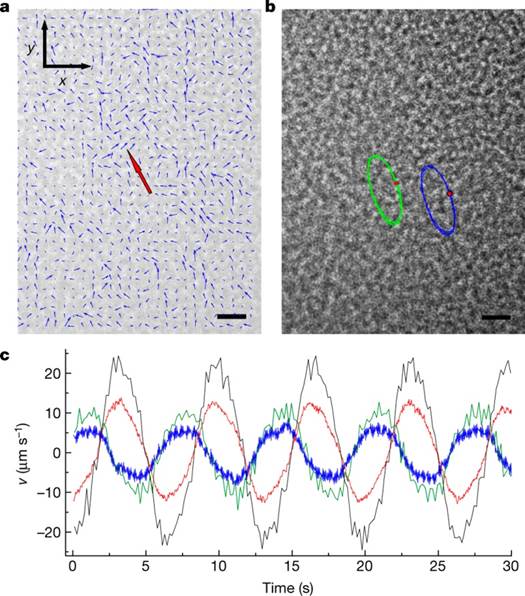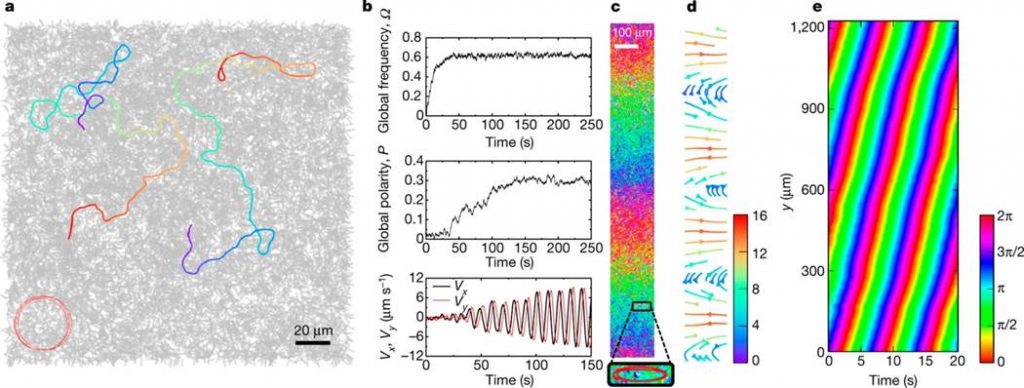
The findings of the PhD students Song Liu and Chong Chen, from the laboratory of Yilin Wu, a biophysicist and faculty member of the Physics Department of the Chinese University of Hong Kong (CUHK), expand the knowledge of self-organized phenomena in biological systems. Collective oscillatory behavior is ubiquitous in nature and it plays a vital role in many biological processes, such as embryogenesis, organ development, and pace-making in neuron networks. Collective oscillations in multicellular systems studied to date often arise from long-range coupling between individual cells that display inherent oscillations. In stark contrast, the collective oscillation in dense bacterial suspension discovered by the team does not require long range coupling, nor even inherent oscillation of individual cells. Instead, it emerges from averaging large numbers of erratic but weakly-coupled trajectories of single bacteria; as a result it is elusive and unnoticed before. The unique mechanism of collective oscillation is possible in diverse biological processes that involve a large population of cells.
The reported phenomenon represents a new type of long-range order in active matter systems, and may be of broad interest to physics and engineering. As a fast-growing and interdisciplinary field, active matter science studies systems composed of units where energy is spent to produce motion. This includes all living organisms from cells to animals, the subcellular constituents driven by molecular motors, and synthetic materials resulting from the self-organization of active elements; self-organization principles learned from these systems may found applications in tissue engineering and in fabricating new bio-inspired devices or materials.
The collective oscillations revealed here constitute the first known instance of weak synchronization of random trajectories. This provides new insights for understanding the physics of self-organization in non-equilibrium systems. The way how this weak synchronization arises from local interactions may inspire new strategies to design swarming robots that are able to perform collective tasks without central control.


See the press release of the Chinese University of Hong Kong :
中大生物物理學家在細菌中發現新的集體運動規律
由香港中文大學的生物物理學者領導的一個國際研究小組發現了一種全新的生物集體運動模式:當成千上萬個細菌處於高密度狀態時,它們看似雜亂無章的運動之中潛藏著高度有序的集體振動。這種所謂“弱同步”現象展示了一種新的多細胞體系集體振動機制,而且構成了一種全新的有序自驅動物質體系。中大物理系助理教授吳藝林與博士研究生劉松、陳崇作出了這項發現。他們的實驗結果和由合作者法國CEA-Saclay的Hugues Chaté以及中國蘇州大學的施夏清發展的數學模型共同揭示出這種自組織集體振動現象可能源於局域作用引起的自發性對稱破缺。該項工作將要在科學期刊《自然》發表。
這項發現擴展了人們對於生物體系中自組織現象的認識。週期性集體振動現象廣泛存在於自然界中,並且在諸如胚胎髮育、器官生長和神經網絡信號同步等許多生物過程中起到重要的作用。生物體系中的集體振動通常需要在自身俱有振動行為的細胞個體之間建立長程的相互作用。與之截然不同,此項研究中發現的周期性集體振動現象並不需要長程相互作用;更重要的是,這一現像中細菌個體行為本身並不存在任何週期性,然而將大量無規則但微弱耦合的單個細菌軌跡統計平均之後,週期性就會浮現出來。換言之,這一現象隱藏在單個細菌的隨機行為之中,因而長久以來被人們忽視了。
細菌所呈現的周期性集體振動現象代表了自驅動物質體系中的一種新的長程序,這將會引起物理學和工程學等領域研究者的廣泛興趣。關於自驅動物質的研究是一個快速發展中的交叉學科,它的研究對像是任何可以利用能量來產生主動運動的物質系統,包括從細胞到動物的所有生命體,由分子馬達驅動的亞細胞組分,以及由自驅動單元組裝而成的合成材料。此項研究所發現的周期性集體振動是首次在實驗中觀察到隨機運動的弱同步現象。這一發現將增進人們對非平衡物理系統自組織過程的理解,也有助於針對智能機器設計更有效的去中心化集群控制策略。
Reference:
|
Weak synchronization and large-scale collective oscillation in dense bacterial suspensions Chong Chen, Song Liu, Xia-qing Shi, Hugues Chaté & Yilin Wu, Nature (2017). (Direct link) |
|
Communiqué CEA : Découverte de mouvements collectifs oscillants chez les bactéries
Collaboration:
- Chong Chen, Song Liu & Yilin Wu: Department of Physics and Shenzhen Research Institute, The Chinese University of Hong Kong, Shatin, Hong Kong, China
- Xia-qing Shi: Center for Soft Condensed Matter Physics and Interdisciplinary Research, Soochow University, Suzhou 215006, China
- Hugues Chaté: Service de Physique de l’Etat Condensé, UMR 3680 CEA, CNRS, Université Paris-Saclay, CEA-Saclay, 91191 Gif-sur-Yvette, France
- and Beijing Computational Science Research Center, Beijing 100094, China
Contact CEA : Hugues Chaté, IRAMIS – SPEC/SPHYNX.





